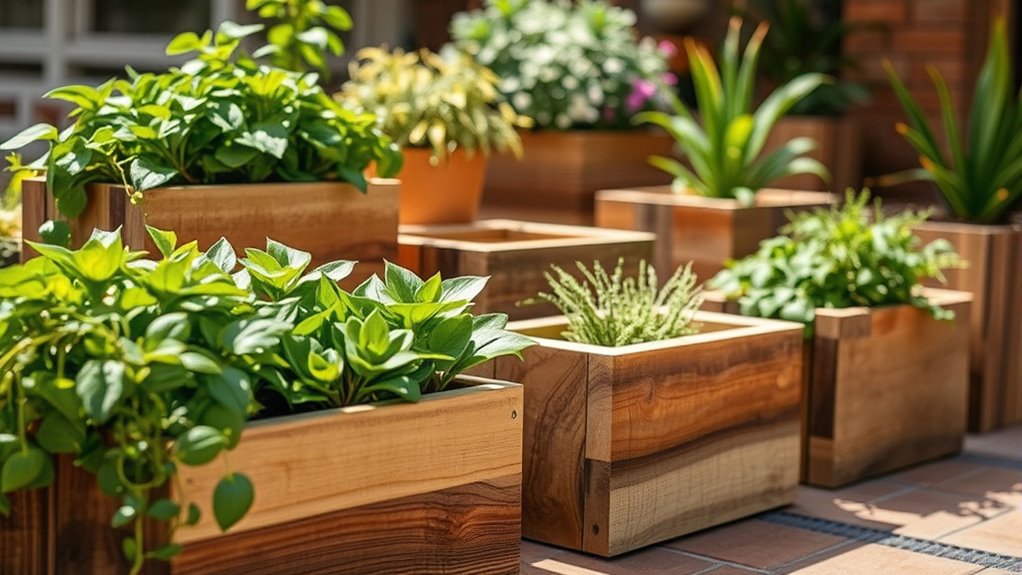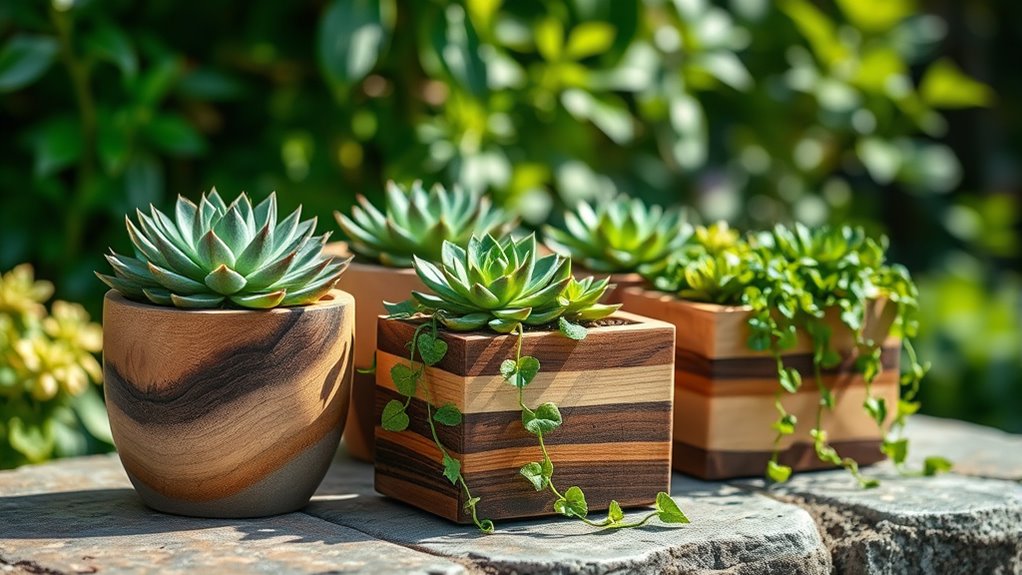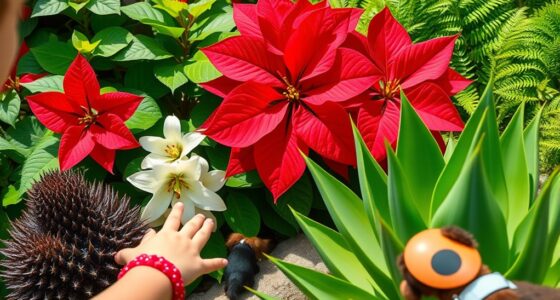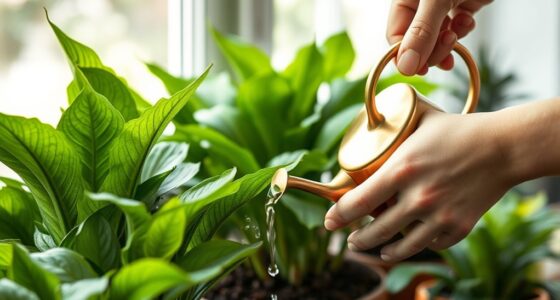Choosing eco-friendly planters made from recyclable or biodegradable materials allows you to garden sustainably and reduce your environmental impact. Recyclable planters, often made from plastics or metals, can be reprocessed and help decrease landfill waste. Biodegradable options, crafted from natural fibers like coconut or rice husks, break down safely over time. Making these eco-conscious choices supports healthier ecosystems and encourages responsible manufacturing. If you want to explore more sustainable options and their benefits, stay with us to learn further.
Key Takeaways
- Recyclable planters made from plastics or metals support waste reduction and promote a circular economy.
- Biodegradable planters from natural fibers decompose naturally, reducing environmental impact.
- Eco-friendly planters are free from toxic chemicals, ensuring safer conditions for plants and ecosystems.
- Using sustainable materials in gardening encourages responsible manufacturing and eco-conscious practices.
- Incorporating eco-friendly planters helps minimize carbon footprint and promotes healthier, greener environments.

Have you ever thought about how your choice of planters can impact the environment? It’s easy to overlook, but the materials you pick for your garden or indoor setup can make a significant difference. By opting for planters made from recyclable materials, you’re helping reduce waste and promote a circular economy. Recyclable planters are often crafted from plastics or metals that can be reprocessed and repurposed at the end of their lifespan. This means fewer items end up in landfills, and you’re contributing to a more sustainable cycle of material use. Choosing recyclable options not only minimizes waste but also encourages manufacturers to develop more eco-conscious products. It’s a simple switch that can have a ripple effect, motivating others to follow suit and prioritize environmentally responsible choices.
Besides recyclable materials, biodegradable options are also gaining popularity among eco-conscious gardeners. These planters are made from natural substances like coconut husks, rice husks, paper pulp, or other plant-based fibers. Unlike traditional plastic planters, biodegradable ones break down naturally over time, returning to the earth without leaving harmful residues. When you select biodegradable planters, you’re supporting a product lifecycle that aligns with nature’s own processes. They’re especially ideal for seedlings or temporary plantings because you can plant them directly into the soil, reducing transplant shock and eliminating waste. This approach helps maintain soil health and decreases the need for plastic disposal. Additionally, biodegradable options often come from renewable resources, making them a more sustainable choice overall. Incorporating plant-based fibers into your gardening supplies further enhances your eco-friendly efforts.
Switching to eco-friendly planters made from recyclable or biodegradable materials isn’t just good for the planet; it influences your gardening habits positively. These materials tend to be safer for your plants and the environment because they lack toxic chemicals often found in conventional plastics. When you incorporate biodegradable or recyclable planters into your gardening routine, you’re actively reducing your carbon footprint and contributing to a healthier planet. It’s about making thoughtful, informed choices that prioritize sustainability without sacrificing style or functionality. Whether you’re a hobbyist or a professional landscaper, these options enable you to create beautiful, environmentally responsible spaces while minimizing your impact. It’s a small step with meaningful benefits, proving that sustainable practices can be simple yet powerful. By choosing wisely, you help promote a greener future where your garden thrives and the environment is protected.
Frequently Asked Questions
Are Eco-Friendly Planters Suitable for Outdoor Weather Conditions?
Yes, eco-friendly planters are suitable for outdoor weather conditions if they have good material durability and weather resistance. You should check the planter’s material to guarantee it can withstand rain, sun, and temperature changes without cracking or fading. When you choose durable, weather-resistant eco-friendly planters, they’ll last longer outdoors, keeping your plants healthy and your space eco-friendly. Always verify these qualities before placing them outside.
How Long Do Sustainable Materials Typically Last in Planters?
Sustainable materials in planters typically last between 3 to 10 years, depending on their durability and exposure. For example, bamboo can last around 5 years outdoors, while recycled plastic may endure up to 10. You can prolong the longevity of planters by choosing high-quality, weather-resistant materials and providing proper maintenance. This ensures your eco-friendly planters stay functional and beautiful for many seasons.
Can Eco-Friendly Planters Be Recycled or Repurposed After Use?
Yes, you can recycle or repurpose eco-friendly planters after use. Many are made from durable materials like biodegradable plastics or recycled content, making them suitable for recycling options at local facilities. You can also repurpose them for storage or craft projects, extending their life. To guarantee proper recycling or reuse, check the manufacturer’s guidance on material durability and recycling instructions, helping you reduce waste effectively.
Do Sustainable Materials Impact Plant Growth or Health?
You’ll notice lush, thriving plants when you choose sustainable materials, as they typically don’t release harmful toxins. These materials positively impact plant nutrient absorption, fostering healthy growth. Unlike toxic options, they don’t compromise your plant’s health or introduce material toxicity. By selecting eco-conscious options, you create an environment where roots flourish, and leaves stay vibrant, ensuring your plants remain happy and healthy in their natural, nurturing surroundings.
Are There Cost Differences Between Traditional and Eco-Friendly Planters?
You’ll find that eco-friendly planters often have a higher cost comparison due to material pricing, but they can be more cost-effective long-term. Traditional planters tend to be cheaper upfront, but eco-friendly options might last longer and offer better insulation. Your choice depends on your budget and priorities. Investing in sustainable materials could save you money over time, especially if you value environmental impact and durability.
Conclusion
By choosing eco-friendly planters made from sustainable materials, you’re not just decorating your space—you’re helping the environment. Imagine your garden thriving with vibrant plants, all housed in planters that decompose naturally, leaving no harmful waste behind. It’s easy to make a positive impact; just pick eco-conscious options. So, next time you plant, think beyond aesthetics—think about the future, and let your choices reflect your commitment to a greener planet.









